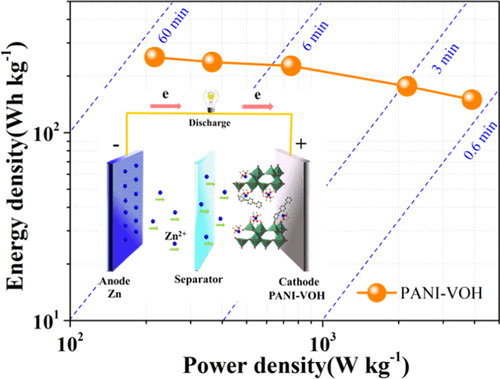当前位置:
X-MOL 学术
›
ACS Appl. Mater. Interfaces
›
论文详情
Our official English website, www.x-mol.net, welcomes your
feedback! (Note: you will need to create a separate account there.)
Graphene-like Vanadium Oxygen Hydrate (VOH) Nanosheets Intercalated and Exfoliated by Polyaniline (PANI) for Aqueous Zinc-Ion Batteries (ZIBs).
ACS Applied Materials & Interfaces ( IF 8.3 ) Pub Date : 2020-06-17 , DOI: 10.1021/acsami.0c10183 Mingshan Wang 1 , Jun Zhang 1 , Linzi Zhang 1 , Jiaqi Li 1 , Wenjie Wang 1 , Zhenliang Yang 2 , Lei Zhang 2 , Yixian Wang 3 , Junchen Chen 1 , Yun Huang 1 , David Mitlin 3 , Xing Li 1
ACS Applied Materials & Interfaces ( IF 8.3 ) Pub Date : 2020-06-17 , DOI: 10.1021/acsami.0c10183 Mingshan Wang 1 , Jun Zhang 1 , Linzi Zhang 1 , Jiaqi Li 1 , Wenjie Wang 1 , Zhenliang Yang 2 , Lei Zhang 2 , Yixian Wang 3 , Junchen Chen 1 , Yun Huang 1 , David Mitlin 3 , Xing Li 1
Affiliation

|
A new approach is employed to boost the electrochemical kinetics and stability of vanadium oxygen hydrate (VOH, V2O5·nH2O) employed for aqueous zinc-ion battery (ZIB) cathodes. The methodology is based on electrically conductive polyaniline (PANI) intercalated–exfoliated VOH, achieved by preintercalation of an aniline monomer and its in situ polymerization within the oxide interlayers. The resulting graphene-like PANI–VOH nanosheets possess a greatly boosted reaction-controlled contribution to the total charge storage capacity, resulting in more material undergoing the reversible V5+ to V3+ redox reaction. The PANI–VOH electrode obtains an impressive capacity of 323 mAh g–1 at 1 A g–1, and state-of-the-art cycling stability at 80% capacity retention after 800 cycles. Because of the facile redox kinetics, the PANI–VOH ZIB obtains uniquely promising specific energy–specific power combinations: an energy of 216 Wh kg–1 is achieved at 252 W kg–1, while 150 Wh kg–1 is achieved at 3900 W kg–1. Electrochemical impedance spectroscopy (EIS) and galvanostatic intermittent titration technique (GITT) analyses indicate that with PANI–VOH nanosheets, there is a simultaneous decrease in the charge transfer resistance and a boost in the diffusion coefficient of Zn2+ (by a factor of 10–100) vs the VOH baseline. The strategy of employing PANI for combined intercalation–exfoliation may provide a broadly applicable approach for improving the performance in a range of oxide-based energy storage materials.
中文翻译:

聚苯胺(PANI)插入和剥落的石墨烯状水合氧合钒(VOH)纳米片,用于水性锌离子电池(ZIBs)。
采用一种新方法来提高用于水性锌离子电池(ZIB)阴极的水合钒氧水合物(VOH,V 2 O 5 · n H 2 O)的电化学动力学和稳定性。该方法基于导电聚苯胺(PANI)嵌入-剥离的VOH,该方法是通过苯胺单体的预嵌入及其在氧化物中间层中的原位聚合实现的。所得石墨烯状PANI-VOH纳米片对总电荷存储容量的反应控制贡献大大提高,导致更多材料经历可逆V 5+至V 3+氧化还原反应。PANI–VOH电极在1 A g –1时可获得令人印象深刻的323 mAh g –1的容量,并且在800次循环后仍保持80%的容量保持不变,具有最新的循环稳定性。由于轻柔的氧化还原动力学,PANI–VOH ZIB获得了独特的有前途的特定能量特定功率组合:在252 W kg –1时达到216 Wh kg –1的能量,而在3900 W时达到150 Wh kg –1的能量千克–1。电化学阻抗谱(EIS)和恒电流间歇滴定技术(GITT)分析表明,使用PANI-VOH纳米片,电荷转移电阻同时降低,Zn 2+的扩散系数提高(由10-100倍)VS的VOH基线。采用PANI进行插层-剥离相结合的策略可能会提供广泛适用的方法,以改善一系列氧化物基储能材料的性能。
更新日期:2020-07-15
中文翻译:

聚苯胺(PANI)插入和剥落的石墨烯状水合氧合钒(VOH)纳米片,用于水性锌离子电池(ZIBs)。
采用一种新方法来提高用于水性锌离子电池(ZIB)阴极的水合钒氧水合物(VOH,V 2 O 5 · n H 2 O)的电化学动力学和稳定性。该方法基于导电聚苯胺(PANI)嵌入-剥离的VOH,该方法是通过苯胺单体的预嵌入及其在氧化物中间层中的原位聚合实现的。所得石墨烯状PANI-VOH纳米片对总电荷存储容量的反应控制贡献大大提高,导致更多材料经历可逆V 5+至V 3+氧化还原反应。PANI–VOH电极在1 A g –1时可获得令人印象深刻的323 mAh g –1的容量,并且在800次循环后仍保持80%的容量保持不变,具有最新的循环稳定性。由于轻柔的氧化还原动力学,PANI–VOH ZIB获得了独特的有前途的特定能量特定功率组合:在252 W kg –1时达到216 Wh kg –1的能量,而在3900 W时达到150 Wh kg –1的能量千克–1。电化学阻抗谱(EIS)和恒电流间歇滴定技术(GITT)分析表明,使用PANI-VOH纳米片,电荷转移电阻同时降低,Zn 2+的扩散系数提高(由10-100倍)VS的VOH基线。采用PANI进行插层-剥离相结合的策略可能会提供广泛适用的方法,以改善一系列氧化物基储能材料的性能。


















































 京公网安备 11010802027423号
京公网安备 11010802027423号